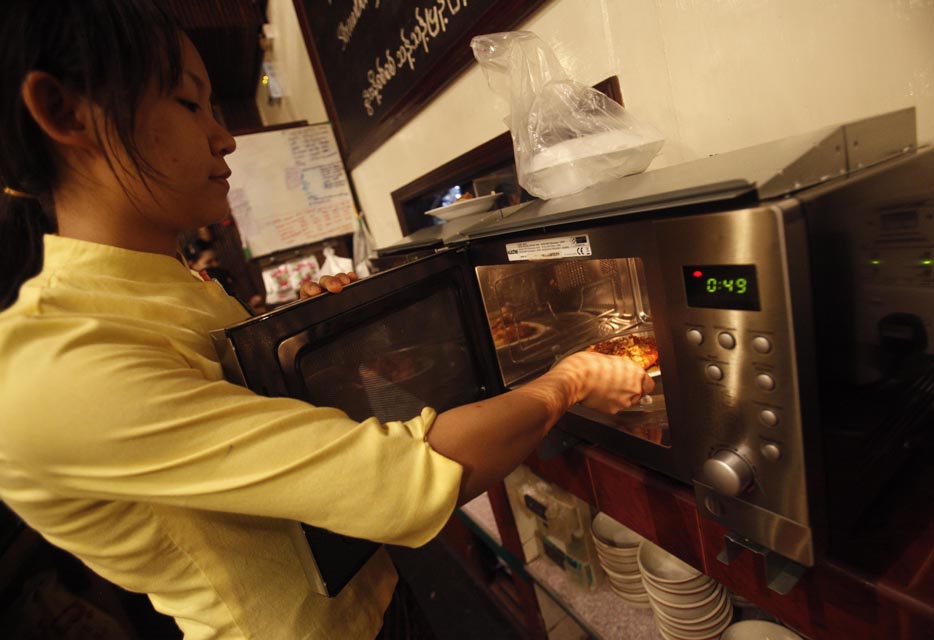It is fair to say that Yangon, the former capital of Myanmar, is not famed for its food. An old Burmese saying goes, “Mandalay sagaa, Mawlamyaing asaa, Yangon akywaa,” or “Mandalay for eloquence, Moulmein for food and Yangon for boasting.”
There is also a general feeling that the best Burmese cuisine is to be found in Burmese homes.
“Rich Burmese people don’t go out to eat Burmese food, they eat it at home,” says Soe Nyi Nyi, the owner of Feel restaurant.
Not everyone visiting Myanmar these days – an estimated 600,000 foreign tourists visited the country in 2012, compared with about half that number in 2011 – will be fortunate enough to be invited to a rich Burmese friend’s home to sample authentic fare.
For those without a local host, but determined to sample the local fare, Yangon offers a variety of well-run restaurants where authentic Myanmar cuisine can be sampled without fear of stomach-related repercussions the following day.
An increasingly popular Yangon-based restaurant chain among expatriates and locals is Feel, with its main outlet on Pyihtaugsu Avenue and eight other branches throughout the city. Feel also has a branch at the only pit stop halfway on the highway between Yangon and Naypyidaw, Myanmar’s capital.
Feel’s founder, Soe Nyi Nyi, originally wanted to specialise in Western cuisine. His first restaurant, Dream, opened in 1992 and sold hamburgers, French fries and milkshakes to Yangon’s upper and middle classes – a limited market.
Soe Nyi Nyi switched to Burmese cuisine under the Feel banner only after he lost most of his Yangon-based market in 2005, when the government suddenly shifted the capital and most of the country’s civil servants to Naypyidaw, 350km to the north.
“Most of my Dream customers were government workers. With Feel, I shifted to Myanmar food to target the lower-middle class,” Soe Nyi Nyi says.
The Feel outlet on Pyihtaugsu Avenue has a classic range of curries, vegetable and soup dishes, which the customers point to and then have delivered to their tables on tiny plates.
One dish costs about 2,000 kyat ($2.30) – expensive by Myanmar standards. A meal for four, with Myanmar beer, can set customers back $20. Like Thai and Chinese cuisine, the dishes are meant to be shared among dinner companions, not enjoyed a la carte. “We make our food clean, and we use quality oil – Brolio brand from Germany,” Soe Nyi Nyi says.
Quality oil makes a big difference in Burmese cuisine, which is not known for its healthy characteristics.
“Yangon curries, in general, tend to be oily,” notes Alfred Birnbaum, a Myanmar cuisine expert who has lived in the country for eight years. “I prefer the salads, ngapi dips, with tosaya parboiled vegetables, and various fried or simmered savouries. The clear soups [hinjo] that are meant to clean the palate between dishes are generally underwhelming.”
It is curry, however, that usually represents the heart of any meal in Myanmar. “Our curries are less spicy than Indian curries and less sweet than Thai curries,” says Than Than Kyin, the manager of the Danuphyu Daw Saw Yi restaurant, another Yangon chain, which opened in 1954.
The chain’s first restaurant, opened by the now deceased Daw Saw Yi from the Danuphyu district in the Irrawaddy Delta, offers 80 different dishes.
Like most central Myanmar cuisine, the Danuphyu restaurant offers no seafood, but a rich variety of freshwater fish and prawns, caught from the Irrawaddy’s numerous tributaries.
“Our most popular dish is our butterfish curry,” Than Than Kyin says, citing a well-known freshwater fish.
Cuisine from Moulmein, on Myanmar’s southeastern coastline, is famed for its seafood. Shan cuisine, from the far north, is also distinctive in that it is closer to Thai food.
“Burmese food is not easy to categorise, not only because of regional cuisines, but also due to the diversity of ethnic cultures,” Birnbaum says. “Burma was a Southeast Asian ‘Yugoslavian tinderbox’ created by the British, who further complicated matters by bringing in Bengali and Gurka labourers en masse – so of course the subcontinental influences are strong.”


